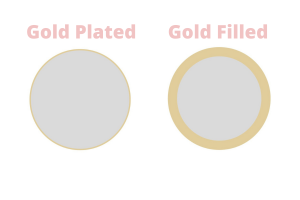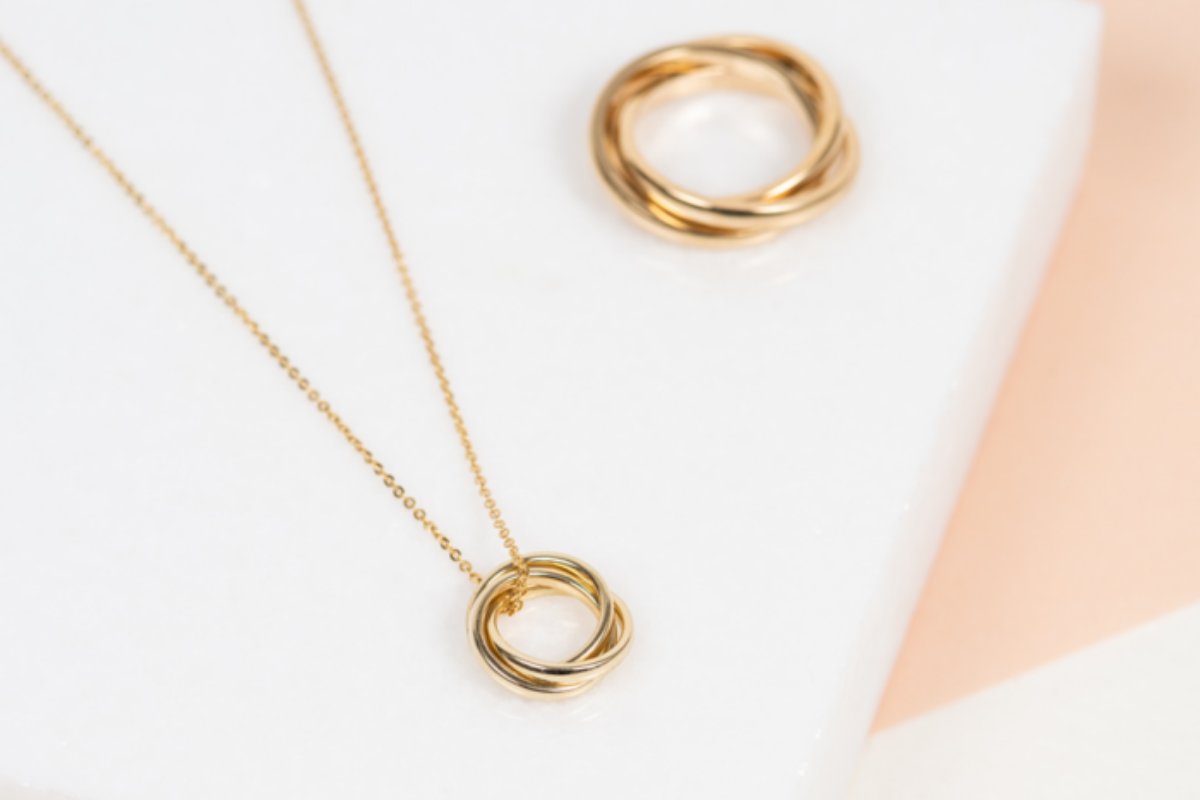Gold jewellery is one of the most popular styles of all time. From its early beginnings (as far back as 4000 BC!), gold jewellery has stood the test of time and it’s really been having a moment with the layering trends of the 2010s. If you’re at all into jewellery – specifically gold jewellery – you’ll have seen the words ‘gold filled’ and ‘gold plated’ floating around. Not sure what they mean? From how they’re made to telling the difference between them, here’s everything you need to know about gold filled and gold-plated jewellery.
What is gold plated jewellery?
There are many types of gold jewellery, including gold vermeil, gold plating, gold filled and solid gold. First, let’s explain what the varieties of gold coated metals mean. The base of most gold jewellery is sterling silver, fine silver, brass or copper. The base is covered in a layer of gold, but it’s the purity and thickness of the gold layer that sets each type apart from each other.
Gold plating is where a thin layer of gold is bonded on to a base metal. Gold plating can be applied to almost any metal, but it tends to be applied to brass, copper or nickel. The total amount or percentage of gold in a gold plated piece is typically 0.05% of the overall weight of the jewellery. Gold plating ranges in thickness between 0.17 to 2.5 microns. This means there is very little gold in comparison to the bass material.
Gold plated jewellery is made using electrolysis. Electrolysis is when an electric current is passed through a substance to effect chemical change. When gold undergoes this process, it becomes a thick coating that can cover the base material. Let’s break this down a bit further. The surface or substrate is cleaned, stripped, polished and sandblasted by a variety of chemical cleaners. This removes anything from the surface that could contaminate the other materials (like dirt or oil) and it improves the stickiness of the layer. After extensive cleaning, a base layer of copper, nickel or brass is added. This is then submerged into the gold plating and a positive electric charge is sent through it which helps fuse the gold to the base. The piece is then rinsed, dried and voila! You have a gold plated piece of jewellery!
Carats, colours & prices of gold plated jewellery
Gold plating may have a small gold percentage, but it’s still made using real solid gold, which gives it a boost in value. Its carats range from 10ct up to 24ct like other gold pieces. Carat is the unit used to measure how much gold is in a piece of jewellery in comparison to other metals present. The thicker the gold plating and higher the carat means better quality.
Due to the thin layer of gold, gold plating is most commonly made into necklaces, watches and earrings. Its colours range from yellow gold, white gold and rose gold, giving you plenty of options when picking your next piece. Pricewise, gold plated jewellery is at the lower end of the spectrum and is an affordable way to start your gold collection. It still has the aesthetic qualities of gold but at an inexpensive price.
What is gold filled jewellery?
Gold filled jewellery is the closest to solid gold and is often confused with it. However, gold filled is made differently and is at a fraction of the cost. Gold filled jewellery is where a thick layer of gold is pressure bonded on to a base metal – typically silver, copper or brass – using a high amount of heat. It contains an actual layer of gold and legally needs to feature at least 5% of gold by weight to class as gold filled.
Where gold plated jewellery is made through electrolysis, gold filled is made through pressure or heat bonding. A gold sheet is wrapped around the base metal and heat is used to fuse the gold layer and the core together. The gold is mechanically bonded to the base which means it can’t rub off. This process makes the jewellery more durable and gives it a more realistic appearance to gold.
Carats, colours & prices of gold filled jewellery
The gold in gold filled jewellery is much thicker than other types of gold jewellery apart from solid gold. The carat or thickness of gold plated jewellery depends on the thickness of the gold sheet. The gold sheet tends to be between 0.03 – 0.1 millimetres thick. Gold plated pieces start from 10ct up to 24ct and gives a more intense gold colour and quality. In comparison to gold plating and vermeil, gold filled is the better quality and is the more expensive choice.

How to tell when a piece is gold plated or gold filled
There are a few ways to tell if your piece is gold plated or gold filled. The first way is to look at the price tag. Gold plated jewellery is very affordable and tends to be under £50, whereas gold filled is more expensive due to its gold content. The next way is to look for a hallmark or stamp on your piece. Gold filled jewellery is usually stamped with the letters ‘GF’ followed by the carat number and gold weight. Similarly, gold plated jewellery tends to be stamped with ‘GP’ or will feature how it was made, like ‘GEP’ (gold electroplated) or ‘HGE’ (heavy gold electroplated).
There are other technical ways to tell the difference, like acid or electronic testing but you should look to a professional to help you with this!
So, which is best?
Depending on what you’re looking for, what you can afford and how often you plan on wearing it, it’s up to you which is best!
If you have a limited budget, gold plating is the best option as it’s more affordable and more accessible. On the other hand, if you’re looking for a piece that will last a lifetime, it’s a good idea to broaden your budget and go for a gold filled piece. If you’re looking for quality, we’d recommend gold filled jewellery. It’s bound to the metal which means it’s less likely to rub off and it has a higher and thicker gold content.However, if you make sure you’re looking after your jewellery when you buy it from a gold jewelry shop online, you can make a both gold plated or gold filled pieces last forever.
Image credits: aureejewellery.com, simpleanddainty.com.
